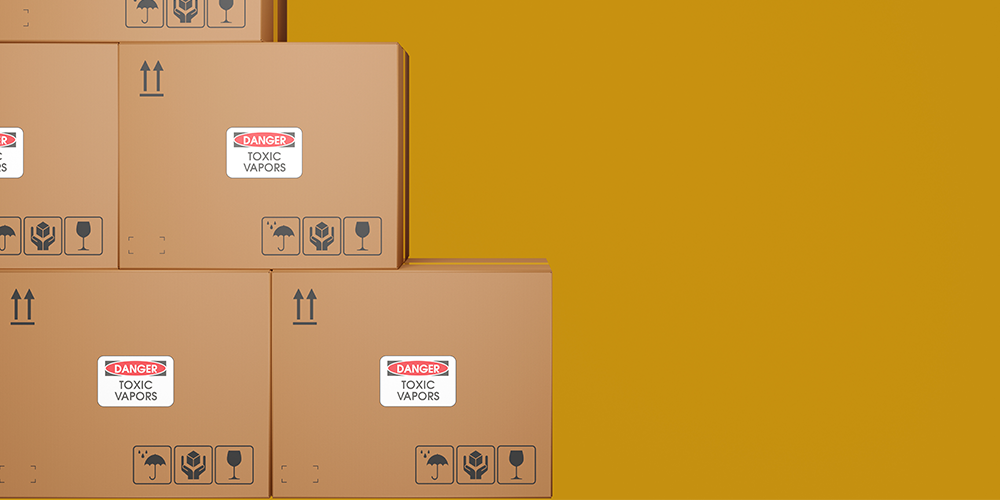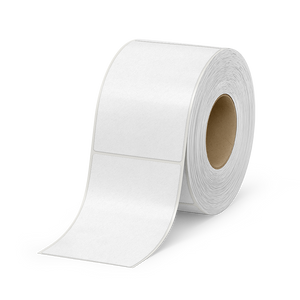Shipping Hazardous Materials with Thermal Labels

Shipping hazardous materials comes with strict rules and real risks. In a logistics or warehouse setting, labels are often the first thing a handler sees—and sometimes the only warning they get. When shipments involve corrosives, flammables, or toxic substances, labels that fade, peel, or smear can lead to serious delays or compliance failures.
Thermal labels are often the right solution. They’re clear, durable, and fast to print—making them ideal for warehouse environments where speed and reliability matter.
When Do You Need Thermal Labels for Hazmat?
Use thermal labels when your shipments include any of the following:
- Hazard materials (flammables, corrosives, gases, etc.)
- UN-labeled drums or containers
- Items exposed to handling, weather, or long transit times
These shipments require label clarity that lasts—from your dock to the final destination. If your packages move through different temperatures, climates, or terminals, paper labels and inkjet printing likely won’t hold up.
Real example: A warehouse in Texas saw smudging on inkjet labels after only two hours on a humid dock. They switched to thermal transfer with resin ribbon—problem solved. Labels stayed sharp, and shipments cleared inspection without hold-ups.
Why Thermal Transfer Works Best in These Conditions
Direct thermal printing can be fast, but it’s not made for long-haul or exposure. In most hazmat scenarios, industrial thermal transfer labels are the better fit. They resist:
- Heat
- Chemical splash
- Abrasion from shifting containers
- Smearing from rough handling
Use waterproof thermal labels if your shipments face rain, condensation, or outdoor storage. These are especially important for drums and barrels that may sit in open yards or ports.
Quick note: Always pair your label material with the right ribbon. For chemical or outdoor exposure, resin or resin-enhanced ribbons give the best results.

Thermal Labeling Tips for Logistics Teams
Making thermal labeling work means choosing the right setup. Here’s how to get it right:
1. Choose a Material That Matches the Risk
- Synthetic labels offer chemical and abrasion resistance
- Paper-based labels may work for short-distance, dry shipments—but not for most hazmat loads
2. Print Settings Matter
- Set the correct media type on your printer
- Use high-contrast print settings to keep codes and symbols crisp
- Avoid using old or partially used ribbons—low ink density leads to blurry hazard symbols
3. Apply Labels on Clean Surfaces
- Wipe down drums, boxes, or pallets before sticking labels
- Moisture and dust reduce adhesion, especially for labels applied in cold environments
4. Use the Right Size and Layout
- Make sure UN ID numbers, hazard symbols, and shipping info are visible
- Avoid placing labels on seams, edges, or curved surfaces without proper adhesive strength
Where to Place Hazard Labels on Packages
Incorrect placement leads to rejected shipments. For hazmat:
- Labels should be on the side of the container, not the top
- They must be fully visible and not covered by straps, tape, or shrink wrap
- Use one label per hazard type, clearly spaced
- If you're labeling a drum or barrel, avoid placing labels on ridges or curves
Tip: Keep a layout example at each labeling station to reduce user error—especially for teams printing labels on demand.
The Role Thermal Labels Play in Compliance and Safety
Labels aren’t just for sorting—they’re legally required and operationally critical. They help prevent mix-ups, inform handlers, and reduce the chance of damage or injury.
In 2022, over 16,000 hazmat incidents were reported to PHMSA. Many stemmed from misidentification, poor labeling, or label damage during transit. Teams that use thermal transfer printers with waterproof thermal labels experience fewer rejected loads and avoid relabeling delays that slow operations.

Common Mistakes to Avoid
Even experienced teams make mistakes. Here's how to prevent the most common ones:
- Wrong label type: Using direct thermal instead of thermal transfer for multi-stop shipments
- Weak print quality: Faded text from incorrect printer settings
- Labeling after wrapping: Applying labels to plastic or shrink wrap instead of containers
- Unlabeled secondary packaging: Forgetting to label inner containers that hold the hazmat material
Before You Label Hazardous Shipments
If you're shipping flammable, corrosive, or toxic goods, thermal labels aren’t just more durable—they’re smarter. They help ensure your labels stay readable, your teams stay compliant, and your shipments stay on schedule.
Need a label that holds up through tough routes, chemicals, and weather? Take a look at our thermal transfer labels for logistics professionals managing hazardous freight across multiple touchpoints.
Frequently Asked Questions
Are thermal labels compliant with hazmat regulations?
Yes—if they include the correct hazard class, UN number, and remain legible through shipping. Always check DOT, OSHA, and GHS requirements for your product category.
Is thermal transfer printing better than direct thermal for hazmat?
In most cases, yes. Thermal transfer labels resist heat, chemicals, and abrasion better than direct thermal. This makes them suitable for long-distance and high-risk shipping.
What if labels fall off during transit?
Shipments may be delayed or rejected. Always apply labels to clean, dry surfaces with strong adhesives. For rough or curved surfaces, choose high-tack label stock.
Can thermal labels be used on metal drums and chemical containers?
Yes—especially synthetic or waterproof labels with permanent adhesive. Avoid paper labels if the container might be exposed to water or solvents.
Do I need to label every package in a multi-carton hazmat shipment?
Yes. Each individual container holding hazardous materials must be labeled, even if they’re grouped on a pallet or inside a larger box.







